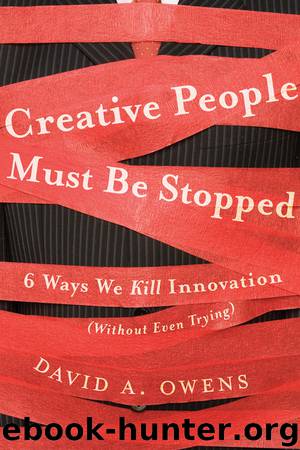Creative People Must Be Stopped by David A Owens

Author:David A Owens [Owens, David A]
Language: eng
Format: epub
Publisher: John Wiley & Sons, Ltd.
Published: 2011-09-28T04:00:00+00:00
Supplier Constraints: No Organization Is an Island
To participate in an industry or sector, organizations typically must negotiate with suppliers that control needed resources, such as raw materials, product modules, ideas, capital, or any other input an organization requires to fulfill its mission. Because suppliers make money by providing components essential to the organization’s operation, you might assume that the suppliers would have the organization’s interest in mind. But this is not necessarily the case. Suppliers may have trouble or be unwilling to provide the resource where the organization needs it; an organization may need your skills, but are you willing to move to Asia to supply them? Suppliers also may balk at helping with innovations they perceive as reducing their importance, or they may have their own bases of power and control, as, for example, skilled labor does through the mechanisms of unions and professional guilds.
Although suppliers to an organization benefit from their relationships with organizations, a number of constraints can arise. Here are three of them.
Suppliers Favoring Their Own Interests
Suppliers of critical goods to an organization—be they raw materials, labor, or even knowledge—have a vested interest in ensuring that there can be no substitute for their contribution to the final product. (Like the organization, they also do not want competition.) This is not a cynical view; it is simply looking at the situation through the lens of economics.
Suppliers therefore have a high incentive to attempt to supply inimitable and otherwise irreplaceable goods and services. These may take the form of highly integrated solutions—for example, supplying the entire dashboard assembly to a car manufacturer. This will make it very difficult for an automobile maker to simply switch to another supplier as a way of lowering prices by driving competition between potential suppliers. While raising the value of the supplier’s contribution to the final product, it also reduces the risk that the client organization can or will change.
Obviously, this can be a significant innovation constraint. Highly integrated and embedded systems are going to be more difficult to modify or improve if they have been supplied in essentially turnkey form, because the detailed understanding of the subsystem belongs to the supplier. For innovation to occur, it will have to be driven by the supplier.
These points apply to services and to smaller organizations, not just to large companies making complex products. Consider one family-operated publishing company that decided belatedly to join the Internet age by engaging an old acquaintance to build a Web site to market its regional publications. The acquaintance, who was used to designing for sizable enterprises with marketing budgets to match, created a beautiful but unconventional design whose workings only he understood. When he eventually gave up maintaining the site (the account, after all, was a small one for him), the mom-and-pop company was left with an elaborate Web site and no easy way to change or update it—the kiss of death for anyone trying to attract and retain eyeballs on the Web.
Difficulty Getting the People You Need
Organizations may also need a supply of motive power and knowledge that comes in the form of human labor.
Download
This site does not store any files on its server. We only index and link to content provided by other sites. Please contact the content providers to delete copyright contents if any and email us, we'll remove relevant links or contents immediately.
Bad Blood by John Carreyrou(6559)
Rich Dad Poor Dad by Robert T. Kiyosaki(6414)
Principles: Life and Work by Ray Dalio(6233)
Playing to Win_ How Strategy Really Works by A.G. Lafley & Roger L. Martin(5941)
Management Strategies for the Cloud Revolution: How Cloud Computing Is Transforming Business and Why You Can't Afford to Be Left Behind by Charles Babcock(4528)
The Confidence Code by Katty Kay(4190)
Thinking in Bets by Annie Duke(4154)
American Kingpin by Nick Bilton(3761)
Delivering Happiness by Tony Hsieh(3369)
Project Animal Farm: An Accidental Journey into the Secret World of Farming and the Truth About Our Food by Sonia Faruqi(3179)
The Power of Habit by Charles Duhigg(3063)
The Tyranny of Metrics by Jerry Z. Muller(3008)
Brotopia by Emily Chang(3002)
Mastering Bitcoin: Programming the Open Blockchain by Andreas M. Antonopoulos(2983)
The Marketing Plan Handbook: Develop Big-Picture Marketing Plans for Pennies on the Dollar by Robert W. Bly(2978)
I Live in the Future & Here's How It Works by Nick Bilton(2940)
The Content Trap by Bharat Anand(2864)
Building a StoryBrand by Donald Miller(2844)
Applied Empathy by Michael Ventura(2839)
